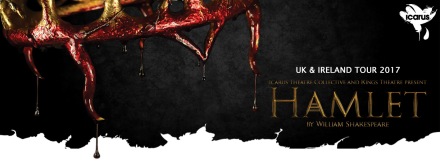Review: Hamlet by Icarus Theatre Collective at Cork Opera House – 6th Feb. 2017
Review by Edel Semple
Icarus Theatre Collective’s Hamlet, on tour in Ireland and the UK at present, packages itself as “Shakespeare for the Game of Thrones generation”. In its set, costumes, and action, the production often nods to the popular HBO series, using the now familiar imagery to enliven and illuminate this iconic tragedy. Every character carried a sword, Gertrude and Claudius donned furs like trophies of a recent hunting party, and the pair sat in thrones decorated with a spear design that illustrated the interests of the “warlike state”. Denmark’s brutish culture, and Hamlet’s alienation from it, was demonstrated early on as, for the court’s entertainment, a brawny Laertes dispatched an opponent in a bloody knife fight. Huge Danish flags formed the backdrop for the stage and the unfussy set, with its pillars and tiered marble steps, provided plenty of scope for the cast to traverse from the battlements to the court to the graveyard. The play script was similarly economical; the performance time was a neat 2 hours 15min and the cuts were effective. For instance, the Fortinbras subplot was omitted entirely, as in many modern stage productions and Olivier and Zeffirelli’s films, and the production was all the better for it.
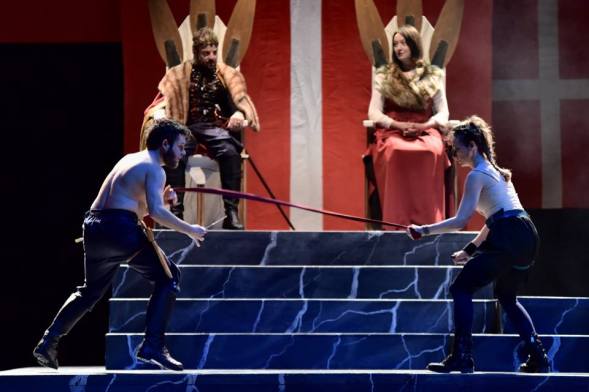
Laertes and his opponent, with Claudius and Gertrude in the background (Credit: Icarus Facebook)
The production had just a cast of nine but it seemed like much more as each actor played numerous roles and characters were rarely alone. On Elsinore’s battlements, for example, seven soldiers stood on guard to be met by Horatio. In their exchange, the soldiers responded like a chorus; they would answer Horatio’s question in unison, or one line would be shared by several speakers. In the opening scene, I found this an irritating distraction – it was, quite simply, clutter that got in the way of clear meaning and performance. Later in the play however, the chorus was used effectively and opened avenues for analysis. When Hamlet attacked Ophelia, the actor playing Gertrude said “get thee to a nunnery” before Hamlet repeated the line to Ophelia. This was perhaps a version of Gertrude in Hamlet’s mind, taking his side and advocating chastity and an all-female environment as women’s only route to safety.
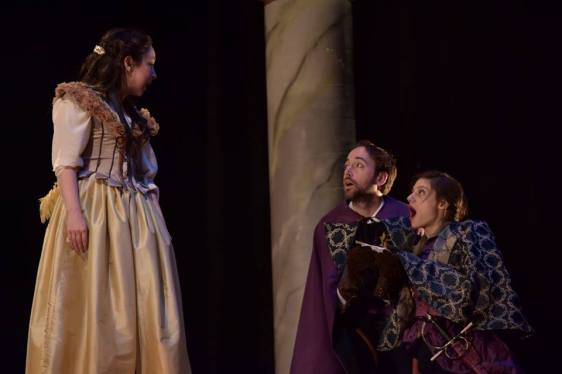
Ophelia recites Hamlet’s letter, now held by Guildenstern and Rosencrantz (Credit: Icarus Facebook)
As Claudius prayed, the chorus sometimes spoke to and for him. When the soldiers informed Hamlet of the Ghost’s appearance, they stood around the stage; their voices acted like an eerie echo chamber and the effect was as disorienting as the supernatural encounter they described. This, however, brings me to a further criticism. Perhaps over-exposure to The Walking Dead and past Hamlets have influenced my expectations of the Ghost, but I feel short-changed when “Old Mole” in no way resembles a corpse (as in the Cumberbatch Hamlet) or a spectre (as in the Branagh and Tennant versions). As in other productions, Icarus’ Claudius doubled as Old Hamlet but when he appeared on stage, save for some smoke and the fear of the soldiers, there were no signs that Old Hamlet was in fact supposed to be a terror-inspiring spectre. Thus as Old Hamlet looked remarkably healthy for a dead man, his scenes were a little lacking.
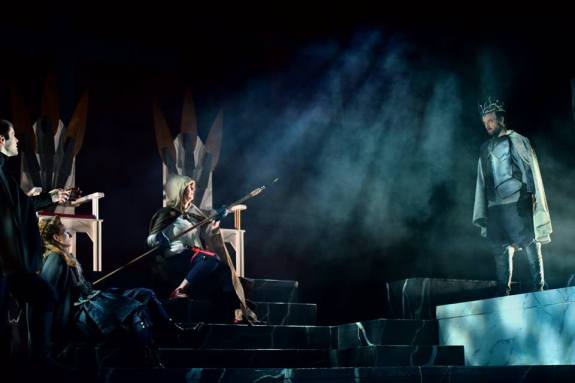
Hamlet (far left), with Horatio (seated), a soldier and the Ghost (Credit: Icarus Facebook)
Overall though, this was a solid production with several flashes of brilliance. Besides the neat cuts to the script and clear vision in the set and costuming, there were striking moments made memorable thanks to the performances of the cast. The tag-team of Rosencrantz and Guildenstern were one of the production’s gems. Cast as a woman and man respectively, Rosencrantz and Guildenstern added some much needed levity to the seriousness of the Danish court. The pair appeared youthful, engaging in slapstick like tripping on the stairs and stealing Hamlet’s letter from Polonius and Ophelia to mock the sentiment. Their betrayal of Hamlet was not an act of malice or cunning, but of immaturity; naively impressed by the king and queen, they held to a misguided allegiance to the monarchy rather than their old friend. In his rejection of the pair (“though you fret me you cannot play upon me”), Hamlet assumed all of his princely authority to banish them from his sight.
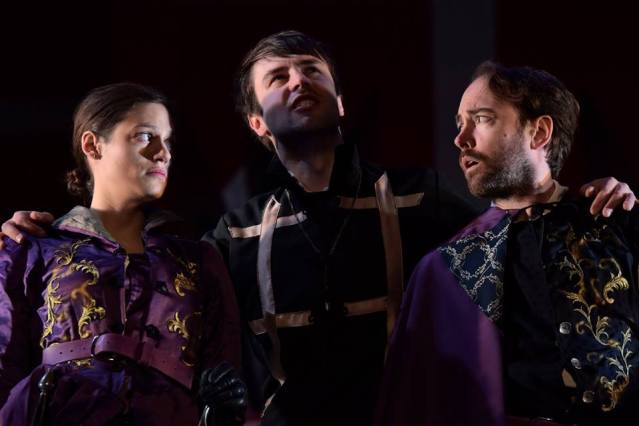
Rosencrantz, Hamlet, and Guildenstern (Credit: Icarus Facebook)
Although youthful, Hamlet was neither an effete intellectual nor a sulky teen. Unlike the erratic hyperactivity or inertia of other Danes, the performance by Icarus’ Hamlet was confident and measured. When Hamlet did display intense emotion then, the impact on the scene was palpable. In the closet scene, Hamlet was pitiful when the Ghost reprimanded him and plain distraught when Gertrude could “see nothing there”. During the Mousetrap, Hamlet jumped to his feet and squared up to Claudius, who visibly bristled with his hand on his sword; for a moment it looked as if vengeance would be had and an alternative ending was in store.
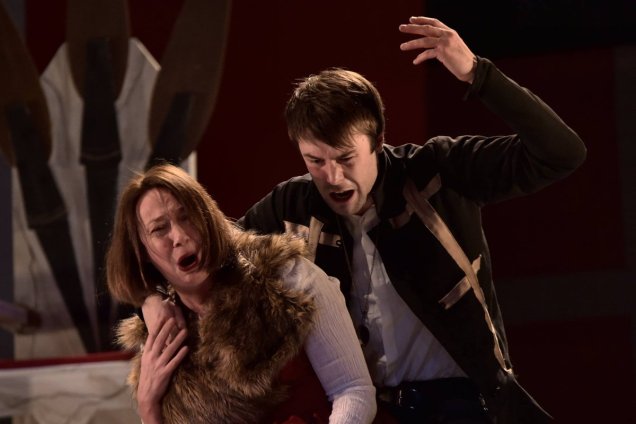
Gertrude and Hamlet in the closet scene (Credit: Icarus Twitter)
In the finale, Gertrude deliberately drank the poisoned wine; she determinedly defied her husband, protected her son, and chose her own (fatal) path. Following soon after, Claudius’ death was an arresting affair that visually recalled the death of Fassbender’s Macbeth; impaled by Hamlet’s sword, the king died kneeling with his back to the audience, his head forever in a penitential bow. Horatio’s performance was also particularly affecting. Cross-gendered casting was typical in the production – intriguingly Ophelia played the Gravedigger, a doubling I’ve not seen before – and Camille Marmié was compelling as Horatio. Surrounded by the bodies of the royals, nobles, and the courtiers murdered by Laertes and Hamlet in their frenzy, Horatio sat forlornly atop a mound of corpses. With the omission of Fortinbras, Horatio’s description of the “carnal, bloody, and unnatural acts” became a soliloquy where, like Hamlet before her, she toyed with the idea of suicide. Her life hung in the balance and, as the sole survivor of the orgy of violence, the audience were invested in her fate. After a tense moment, Horatio finally cast the poisoned chalice aside and the scene cut to black. Such was the strength of both performances, I could envision the actors playing Horatio and Hamlet exchange roles as Faustus and Mephistophilis did in the RSC Doctor Faustus (2016).
All in all, Icarus Theatre Collective’s Hamlet is an invigorating and stylish production that captures the attention from the opening scene to Horatio’s last word.
—
Icarus Theatre Collective’s Hamlet concludes its tour of Ireland in the Siamsa Tíre Theatre, Tralee, Co. Kerry, on 13th-14th February 2017. More information on the touring schedule, cast etc. can be found on the Icarus Theatre Collective’s website here.
